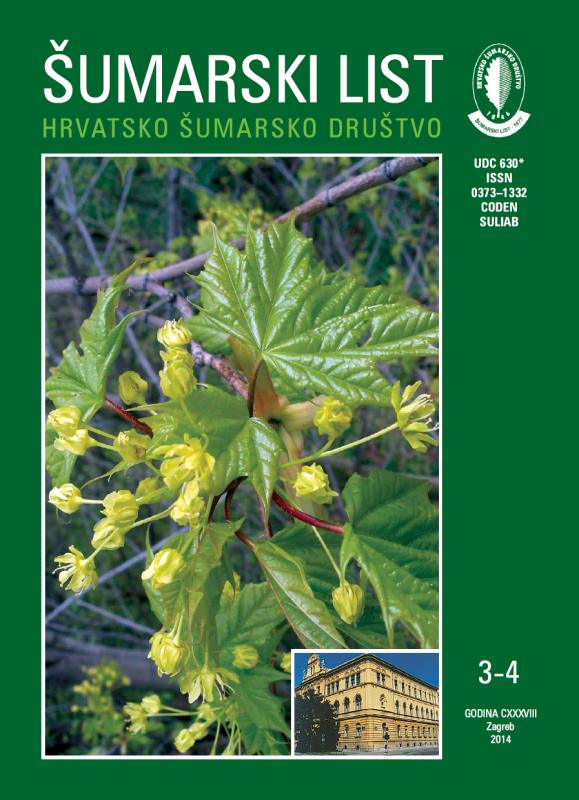
broj: 3-4/2014
pdf (8,09 MB) |
|
||||||||||||||
| RIJEČ UREDNIŠTVA | ||
| Uredništvo | ||
| THE STATUS AND POSSIBILITIES OF A MORE ACCURATE EVALUATION OF FORESTS AND FORESTRY AS PART OF THE ECONOMY OF THE REPUBLIC OF CROATIA pdf HR EN | 121 | |
| IZVORNI ZNANSTVENI ČLANCI | ||
| Jura ČAVLOVIĆ, Krunoslav TESLAK, Karlo BELJAN | UDK 630*569+653+231 (001) | |
| THE EFFECTS OF DIFFERENT STAND REGENERATION PLANNING ON MANAGEMENT AND PEDUNCULATE OAK FOREST DEVELOPMENT – A SMALL SIZE MANAGEMENT CLASS CASE STUDY pdf HR EN | 123 | |
| Summary Pedunculate oak forests in Croatia are characterized with an irregular age-class distribution (larg share of mature stands), pedunculate oak dieback and decreasing stand structure quality, as well as large sized stands and they spatial heterogenity (density of pedunculate oak). Future management and development of the forest depend on actual age-class structure, intensity and spatial-temporal dynamics of forest regeneration. Thereby, spatial dividing of an appropriate size areas (new stands) and defining priority of their regeneration over future periods, which should be based on an objective criteria (e.g. potential rent difference as a consequence of the decision of regeneration (prompt or adjournment) of a potentially mature pedunculate oak stands), is key question. Based on developed computer program application, paper aim is to research effects of two opposite approaches of regeneration priority stand ranking and different intensities of forest regeneration on: stands growth, development of age-class structure and spatial forest structure, as well as possible trends in amounts and values of future revenues. Object of the research is real even-aged forest (management class of pedunculate oak) in Opeke management unit. Area of the forest is 429.5 ha divided into 26 stands of average area of 16.5 ha. Youngest stand is 107 years old and the oldest is 185 years. There is large deviation between actual and theoretical age-class distribution of the forest (table 1). Projection of management and spatial-temporal development of the even-aged pedunculate oak forest over future fourteen 10-year periods (rotation) is performed by computer program SIMPLAG (Teslak i dr., 2012). Within "theoretical" intensity of regeneration (30 ha in 10-year regeneration area, 2–6 ha stand regeneration size, 250 m minimal distance between regenerated stands), and intensive regeneration (50 ha in 10-year regeneration area, 3–13 ha stand regeneration size, 250 m minimal distance between regenerated stands), there were two approaches of regeneration priority stand ranking: – stand regeneration ranking according to lowest potential rent difference (poor structure stand has highest regeneration priority – NSR); – stand regeneration ranking according to highest potential rent difference (well structure stand has highest regeneration priority – OSR) Different management approach validation is performed using comparison and deviation indices (actual vs. theoretical management criteria average deviation). Results showed that less intensive regeneration approach with appurtenant requirements would lead to development of an optimal forest structure as to larger number, smaller sized (5 ha average area), and more homogeneous stands (fig. 1a). Development of age-class forest structure has indirectly manifested in trends of average stand age (fig. 1b). An approach of intensive forest regeneration would result with fast decrease of average stand age, oscillating around theoretical stand age and never would achieve theoretical age-class structure. A question of maintenance and conservation of pedunculate oak stands for long period, up to stand age above 250 years, is very important, particular in a case of less intensive regeneration over long regeneration period of forest. Influence of forest regeneration intensity and approach of regeneration priority stand ranking on trends and total amont of forest growing stock, intermediate and regeneration fellings (fig. 2, tab. 2 and 3), as well as on value of fellings (fig. 3, tab. 2 and 3), has obtained. More intensive regeneration would result with larger average growing stock, total fellings and gross/net value of fellings, meanwhile with large deviations around theoretical models. Approach of priority regeneration of poor quality stands would achieve larger amounts of fellings and revenues too, but with less deviations, what is in terms of sustainability, more acceptable. Future forest management for the forest (and forests of such structure) based on gradually forest regeneration over longer period, by priority regeneration of areas up to 5 ha within poor quality structure parts of current forest stands (new stands), is recommended. This management approach would lead to forming of an appropriate spatial forest structure and development of a balanced age-class structure, with the highest ecological and economic effects. Key words: pedunculate oak; age-class distribution; stand structure; rent; regeneration priority; planning of regeneration felling | ||
| Dalibor Ballian, Alma Hajrudinović, Jozo Franjić, Faruk Bogunić | UDK 630*164 (Quercus trojana Webb.) (001) | |
| MORPHOLOGICAL VARIABILITY OF THE LEAVES OF THE MACEDONIAN OAK Quercus trojana WEBB.) IN BOSNIA AND HERZEGOVINA AND MONTENEGRO pdf HR EN | 135 | |
| Krunoslav Arač, Milan Pernek | UDK 630*453 (001) | |
| OCCURRENCE AND SPREADING OF THE LARGE LARCH BARK BEETLE (Ips cembrae) IN CROATIA AND POSSIBLITIES OF MONITORING BY USING PHEROMONE TRAPS pdf HR EN | 145 | |
| Maja Popović, Mladen Ivanković, Saša Bogdan | UDK 630* 165 + 181.8 (001) | |
| VARIABILITY OF HEIGHT GROWTH AND SURVIVAL OF PROGENIES FROM PEDUNCULATE OAK (Quercus robur L.) SEED STANDS AT THE FIELD TRIAL ‘JASTREBARSKI LUGOVI’ – FIRST RESULTS pdf HR EN | 155 | |
| Ivana Vitasović Kosić, Mihaela Britvec | UDK 630*187 + 268 (001) | |
| FLORISTIC AND VEGETATION CHARACTERISTIC OF FOREST EDGES AND GRASSLANDS OF ĆIĆARIJA (CROATIA) pdf HR EN | 167 | |
| PRETHODNO PRIOPĆENJE | ||
| Manana Kereselidze, Slavimira Draganova, Daniela Pilarska, Andreas Linde | UDK 630*453 | |
| SUSCEPTIBILITY OF Lymantria monacha AND L. dispar TO THE ENTOMOPATHOGENIC FUNGUS Isaria fumosorosea WIZE pdf HR EN | 185 | |


